|
|
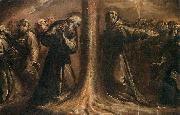 |
Giovanni Battista Crespi
|
|
Giovanni Battista Crespi (23 December 1573 - 23 October 1632), called Il Cerano, was an Italian painter, sculptor, and architect.
He was born in Romagnano Sesia, the son of a painter, Raffaele Crespi, and moved to Cerano with his family some years later. In 1591 he is known to have been living in Milan.
True to the Counter-Reformation piety zealously expressed in Milanese art of his time, his paintings focus on mysteries and mystical episodes in saintly life. The crowded canvases and the angles recall Mannerism, but his paintings show an emotion that evokes common sentiments in Baroque art. Along with other artists, he completed a series of paintings (Quadroni of St. Charles) of the life of St. Charles Borromeo[1] for the Duomo of Milan, an altarpiece with the Baptism of St. Augustine for San Marco (Milan), and a Mass of St. Gregory for the Basilica of San Vittore in Varese (1615-17). Also see the nightmarish, St. Gregory Delivers the Soul of a Monk (1617), also in San Vittore. |
|
|
|
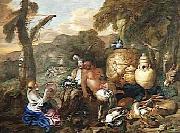 |
Giovanni Benedetto Castiglione
|
|
was an Italian Baroque artist, painter, printmaker and draftsman, of the Genoese school. He is best known now for his elaborate engravings, and as the inventor of the printmaking technique of monotyping. He was known as Il Grechetto in Italy and in France as Le Benedette.
|
|
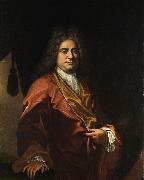 |
Giovanni Camillo Sagrestani
|
|
(1660-1731) was an Italian painter of the Baroque era.
A native of Florence, he was a follower of the style of Carlo Cignani. His major pupil was Matteo Bonechi (1672-1726) and Giovanni Battista Ranieri del Pace. Four canvases attributed to Sagrestani can be found in the church of Santa Maria della Fraternite in Foiano della Chiana. He also executed works in the church of San Frediano in Cestello, in the Oltrarno district of Florence. Paintings in the church of SS. Annunziata in San Giovanni Valdarno are attributed to Sagrestani. An Assumption of the Virgin is found in Nancy. |
|
|
|
|
|
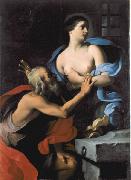 |
Giovanni Domenico Cerrini
|
|
(1609-1681), also called Gian Domenico Cerrini or il Cavalier Perugino, was an Italian painter of the Baroque period, active mainly in Rome and influenced in large part by painter of the Bolognese School.
Born in Perugia, Cerrini initially apprenticed under Giovanni Antonio Scaramuccia, then in 1638 moved into the Roman studio of Guido Reni, but strongly influenced by Lanfranco, Guercino, Domenichino, and Andrea Sacchi. He was patronized by the family of Cardinal Bernardino Spada. Cardinal Giulio Rospigliosi gave him the commission to decorate the cupola of Santa Maria della Vittoria (1654-5). His style has the monumental clarity of Domenichino, but somewhat sapped of vitality.
Paintings of his can be found in many of the churches of Rome, where he died, including Santa Maria in Traspontina, San Carlino alle Quattro Fontane, Chiesa Nuova, San Carlo ai Catinari, Santissimo Sudario dei Piemontesi, Sant??Isidoro, as well as in Galleria Colonna, Palazzo Spada, and the Palazzo Corsini art gallery. |
|
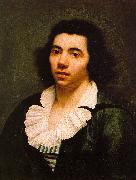 |
Girodet-Trioson, Anne-Louis
|
|
French Neoclassical Painter, 1767-1824
French painter. Originally named Girodet de Roussy or Roucy, he was a student of J.-L. David, and his classical training was sometimes at variance with his often eccentrically romantic expression. He won the Prix de Rome and while in Italy painted the Sleep of Endymion (1791; Louvre), a sensual and erotically ambiguous work that brought him widespread recognition. His Deluge (Louvre) demonstrates Girodet's interest in unusual color and lighting problems. Much of his work, including a series for Malmaison (Napoleon's residence), glorifies Napoleon. |
|
 |
Girolamo da Carpi
|
|
(1501-1556) was an Italian painter and decorator who worked at the Court of the House of Este in Ferrara. He began painting in Ferrara, by report apprenticing to Benvenuto Tisi (il Garofalo); but by age 20, he had moved to Bologna, and is considered a figure of Early Renaissance painting of the local Bolognese School.
He trained in the studio of a local painter who showed the influence of Lorenzo Costa and Raphael. In the 1520s Girolamo visited Rome and Bologna and was inspired by the Mannerist style of Giulio Romano. Geographically and stylistically he straddles the various influences.
He returned to Ferrara and collaborated with Dosso Dossi and Garofalo among others on commissions for the d'Este family. Girolamo became the architect to Pope Julius III in 1550 and supervised the remodeling of the Vatican's belvedere. Returning to Ferrara, he was charged of the enlargements of the Castello Estense.
Da Carpi's paintings include a Descent of the Holy Spirit, in the church of St Francis at Rovigo; a Madonna, an Adoration of the Magi, and a St. Catharine at Bologna; and the St. George and the St. Jerome at Ferrara.
|
|
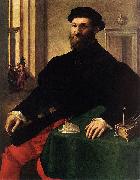 |
Giulio Campi
|
|
(1500 - 5 March 1572) was an Italian painter and architect. His brothers Vincenzo Campi and Antonio Campi were also renowned painters.
The eldest of a family prominent painters, Campi was born at Cremona. His father Galeazzo (1475-1536) taught him the first lessons in art.
In 1522, in Mantua, he studied painting, architecture, and modelling under Giulio Romano. He visited Rome, became an ardent student of the antique, and like Bernardino e distantly related to him e he combined a Lombard and Roman traditions. He collaborated on some works with Camillo Boccaccino, the son of Boccaccio Boccaccino, with whom Campi may also have received training.
Campi is called the "Ludovico Carracci of Cremona" although he preceded the founder of the Eclectics. When but twenty-seven Giulio executed for the church of Sant' Abbondio his masterpiece, a Virgin and Child with Sts. Celsus and Nazarus, a decoration masterly in the freedom of its drawing and in the splendour of its colour. His numerous paintings are grandly and reverently conceived, freely drawn, vigorously coloured, lofty in style, and broadly handled. He was animated in all his work by a deep piety. Numerous of his fresco works are housed in churches of Cremona, Mantua, Milan and in the church of Saint Margaret's, in his native town. Among his chief works are the Descent from the Cross (S. Sigismondo) at Cremona, and the frescoes in the dome of S. Girolamo at Mantua. An altar-piece in S. Sigismondo and his Labours of Hercules were engraved by the celebrated Ghiso, il Mantovano.
He died in Cremona in 1572.
|
|
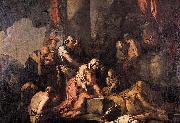 |
Giulio Carpioni
|
|
(1613 - 29 January 1678) was an Italian painter and etcher of the early Baroque era.
Born probably in Venice, Carpioni studied under Alessandro Varotari (il Padovanino) and was also influenced by the work of Simone Cantarini, Carlo Saraceni and Jean Leclerc. He came into contact with Lombard art after a brief visit to Bergamo in 1631. In 1638 he settled in Vicenza and executed most of his work there.
He painted history and bacchanals, and also sacred subjects of a small size, many of which are to be seen in the churches in the Venetian states. Paintings by him may be seen in the Galleries of Augsburg, Dresden, Vienna, Modena, and Florence. He was also an etcher; his best plates being St. Anthony of Padua, Christ on the Mount of Olives, The Virgin reading, and The Virgin with Rosary. He died at Verona. Carlo Carpioni, his son, was also a painter.
Among his important works are the Apotheosis of the Dolfin family (1647) and the Allegory of the Grimani Family (1651), and altarpiece of Sant'Antonio da Padova, a Virgin and two saints, and a Triumph of Silenus in the Gallerie dell Accademia of Venice. He painted a series of canvases for the Oratory of San Nicola da Tolentino in Vicenza.
|
|
 |
Giulio Cesare Procaccini
|
|
1574-1625 Italian Giulio Cesare Procaccini Gallery
Giulio Cesare Procaccini (1574-1625) was an Italian painter and sculptor of the early Baroque era in Milan.
Born in Bologna he was son of the Mannerist painter Ercole Procaccini the Elder and brother of Camillo Procaccini and Carlo Antonio Procaccini. The family moved to Milan around 1585 with the help of the rich art collector Pirro Visconti.
He began as a sculptor in the Cathedral and in the Milanese church of Santa Maria presso San Celso. In 1610 he painted six of the Quadroni, large canvases celebrating Saint Charles Borromeo .
Among his many altarpieces are the Circumcision now in Galleria Estense, Modena (c.1616) and the Last Supper (1616) for Convent associated with the Basilica della Santissima Annunziata del Vastato in Genoa. He also painted the Scourging of Christ.
He worked with Giovanni Battista Crespi (il Cerano) and Pier Francesco Mazzucchelli (il Morazzone) following the directions of Cardinal Federico Borromeo, patron of the arts and cousin of Charles Borromeo. He also painted small religious canvases for rich families, in Milan and in Genoa, where he saw the works of Rubens.
His style shows the influence of Bolognese Mannerism and Venetian colorism and marks the beginning of the Baroque. |
|
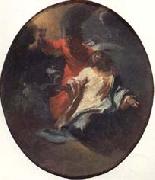 |
Giuseppe Bazzani
|
|
Italian Baroque Era Painter, 1690-1769
was an Italian painter of the Rococo. Born in Mantua to a goldsmith, Giovanni Bazzani, early on he apprenticed with the Parmesan painter Giovanni Canti (1653-1715). A fellow pupil was Francesco Maria Raineri. He spent most of his life in Mantua. From 1752, he was faculty, and from 1767, director of the Accademia di Belle Arti of Mantua. While esconced in a declining provincial city, he absorbed international influences. His loose brushstrokes, fervid often dark emotionalism, and tortured poses, which recall at times later expressionism, display stylistic tendencies more typical of Lombardy. Numerous artists, including Fetti, Bencovich, Rubens, and Magnasco are said to have influenced him, although the number and diversity of the artists suggested hints that he had an idiosyncratic and unique synthesis for his time. Among his early works are paintings of the Miracles of Pius V, the Conversion of a Heretic and the Healing of a Madwoman |
|
 |
Giuseppe Cades
|
|
(December 8, 1750 - December 8, 1799) was an Italian sculptor, painter, and engraver.
Judgment of Solomon, Royal Academy of Arts, London.He was born in Rome. He studied under Mancini and Domenico Corvi, gaining a prize in 1765 with his picture of Tobias recovering his Sight. He visited Florence in 1766, and two years later executed an altar-piece for San Benedetto in Turin and in 1771 another for the Santi Apostoli. He also decorated the Palazzo Chigi with frescoes, landscapes, and scenes from Tasso. He has left two etchings, Christ blessing Little Children and The Death of Leonardo da Vinci. He died in Rome. |
|
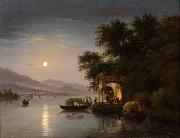 |
Giuseppe Canella
|
|
(28 July 1788 - 11 September 1847), also referred to as Giuseppe Canella the Elder, was an Italian painter.
Initially trained by his father Giovanni, an architect, fresco painter and set designer, Giuseppe Canella started out producing stage sets and decorating stately homes in Verona and Mantua. It may have been under the influence of Pietro Ronzoni, a landscape painter of international renown active in Verona, that he took up landscape. The first views were not produced until 1815, after a short stay in Venice. After making his debut at the Esposizione di Belle Arti di Brera of 1818, he made a long journey through Spain, the Netherlands and France for study purposes. The set of 13 landscapes shown at the Esposizione di Belle Arti di Brera in 1831 proved a great success with the public and critics alike, not least due to the fame achieved in Paris with works exhibited in the Salons, commissions from Louis Philippe of Orleans and the award of a gold medal in 1830. He returned to Milan in 1832 and devoted his energies to urban views characterised by an interest in the events of contemporary life and an atmospheric form of portrayal in evident competition with Giovanni Migliara. Landscape came to predominate as from 1835 with subjects drawn from the Lombard countryside and lakes. The focus on poor and humble aspects of life formed part of the artistes fundamental naturalism and coincided with a moralistic approach derived from the novelist Alessandro Manzoni. Crucial importance attaches in the artistes mature period to his trip to Rome and Naples in 1838-39.
|
|
|
|
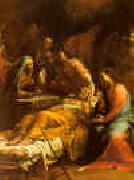 |
Giuseppe Maria Crespi
|
|
1665-1747
Italian
Giuseppe Maria Crespi Locations
1747). Painter, draughtsman and printmaker. His religious and mythological works are distinguished by a free brushstroke and a painterly manner. He also painted spirited genre scenes, which by their quality, content and quantity distinguish him as one of the first Italian painters of high standing to devote serious attention to the depiction of contemporary life. Such paintings as Woman Laundering (1700-05; St Petersburg, Hermitage) or Woman Washing Dishes (1720-25; Florence, Uffizi) offer straightforward glimpses of domestic chores in images that are startlingly novel for the period and look forward to the art of Jean-Simeon Chardin, Jean-Francois Millet and Honore Daumier |
|
|
|
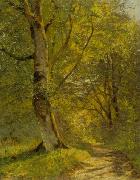 |
Godfred Christensen
|
|
(23 July.1845 - 15 November 1928) was a Danish landscaoe painter. He belonged to the transition between Romanticism and Realism. studied at the Royal Danish Academy of Fine Arts in Copenhagen from 1860 to 1867. |
|
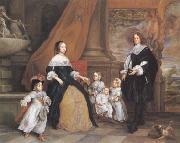 |
Gonzales Coques
|
|
1615 - 1684
was a Flemish Baroque painter He was the son of Pieter Willemsen Coques, a respectable Flemish citizen, and not, as his name might imply, a Spaniard, was born in Antwerp. In 1626?C28 he entered the studio of Pieter Brueghel the Younger, and subsequently studied with David II Rijckaert.He is primarily known as a painter of small cabinet conversation pieces, a type of elegant informal group portrait that he is credited with inventing. The influence of Anthony van Dyck resulted in his nickname "Little van Dyck". After a period of travel, probably to England where Van Dyck was active, he entered Antwerp's Guild of St. Luke in 1640?C41. He was married twice, first to Ryckaert's daughter Catharina, and then to Catharina Rysheuvels. He was a member of two rhetorician guilds in the city, and twice he was made president of the painters' guild. This small portraits were in great demand with both the bourgeoisie and nobility.Patrons included Frederick William, Elector of Brandenburg, Frederick Henry, Prince of Orange and John of Austria the Younger. One of his canvases in the gallery at the Hague represents a suite of rooms hung with pictures, in which the artist himself may be seen at a table with his wife and two children, surrounded by masterpieces composed and signed by several contemporaries. Partnership in painting was common amongst the small masters of the Antwerp school; and it has been truly said of Coques that he employed Jacob von Arthois for landscapes, Anton Ghering and Willem Schubart von Ehrenberg for architectural backgrounds, Hendrik Steenwijck the younger for interiors, and Pieter Gysels for still life and flowers; but the model upon which Coques formed himself was Van Dyck, |
|
|
|
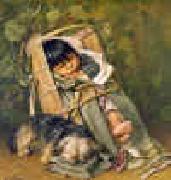 |
Grace Carpenter Hudson
|
|
1865-1937
Grace Carpenter Hudson Galleries
Grace Carpenter Hudson (1865 - 1937) was an American painter. She was nationally known during her lifetime for a numbered series of more than 684 portraits of the local Pomo Indians. She painted the first, "National Thorn", after her marriage in 1891, and the last in 1935.
Grace Carpenter was born in Potter Valley, California. Her mother was one of the first white school teachers educating Pomo children and was a commercial portrait photographer in Ukiah, California; her father was a skilled panoramic and landscape photographer who chronicled early Mendocino County frontier enterprises such as logging, shipping and railroading.[1] At fourteen years of age, Grace was sent to attend the recently-established San Francisco School of Design, an art school which emphasized painting from nature rather than from memory or by copying existing works. At sixteen, she executed an award-winning, full length, life sized self-portrait in crayon. While in San Francisco, she met and eloped with a man fifteen years her senior named William Davis, upsetting her parents and ending her formal studies. The marriage lasted only a year.
From 1885 to 1890, Grace Carpenter Davis lived with her parents in Ukiah painting, teaching and rendering illustrations for magazines such as Cosmopolitan and Overland Monthly. Her work at that time had no particular focus and included genre, landscapes, portraits and still lifes in all media. Later in her career she would continue to accept occasional magazine illustration assignments including ones for Sunset. |
|
|
|
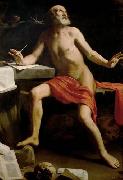 |
Guido Cagnacci
|
|
(January 19, 1601 - 1663) was an Italian painter of the late-Baroque period, belonging to the Forle painting school and to the Bolognese School.
Born in Santarcangelo di Romagna near Rimini, he died in Vienna in 1663. He worked in Rimini from 1627 to 1642. After that, he was in Forle, where absorbed the lesson of the Melozzo's painting.
Prior to that he had been in Rome, in contact with Guercino, Guido Reni and Simon Vouet. He may have had an apprenticeship with the elderly Ludovico Carracci. His initial output includes many devotional subjects. But moving to Venice under the name of Guico Baldo Canlassi da Bologna, he renewed a friendship with Nicolas Regnier, and dedicated himself to private salon paintings, often depicting sensuous naked women from thigh upwards, including Lucretia, Cleopatra, and Mary Magdalene.This allies him to a strand of courtly painting, epitomized in Florence by Francesco Furini, Simone Pignoni and others. In 1650, he moved to Venice. In 1658, he traveled to Vienna, where he remained under patronage of the emperor Leopold I.
His life was at times tempestuous, as characterized by his failed elopement (1628) with an aristocratic widow. Some contemporaries remark him as eccentric, unreliable and of doubtful morality. He is said to have enjoyed the company of cross-dressing models. |
|
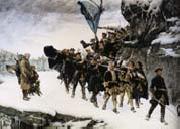 |
Gustaf Cederstrom
|
|
Swedish Painter, 1845-1933,was a Swedish painter, most known for his painting Karl XII:s likfärd (The funeral transport of Charles XII). He was born and raised in Stockholm. His father was Carl Emanuel Cederström and his mother was Carolina Fredrika Theresia af Ugglas. He married Amalia Katarina Jaeder in 1878 |
|
 |
Gustave Caillebotte
|
|
French Impressionist Painter, 1848-1894
Gustave Caillebotte was born on August 19, 1848 to an upper-class Parisian family. His father, Martial Caillebotte (1799-1874), was the inheritor of the family textile industry and was also a judge at the Seine Tribunal de Commerce. Caillebotte father had been twice widowed before marrying Caillebotte mother, C??leste Daufresne (1819-1878), who had two more sons after Gustave, Rene (1851-1876) and Martial (1853-1910). |
|
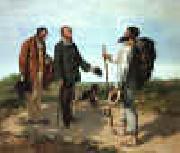 |
Gustave Courbet
|
|
1819-1877
French
Gustave Courbet Locations
was a French painter whose powerful pictures of peasants and scenes of everyday life established him as the leading figure of the realist movement of the mid-19th century.
Gustave Courbet was born at Ornans on June 10, 1819. He appears to have inherited his vigorous temperament from his father, a landowner and prominent personality in the Franche-Comte region. At the age of 18 Gustave went to the College Royal at Besancon. There he openly expressed his dissatisfaction with the traditional classical subjects he was obliged to study, going so far as to lead a revolt among the students. In 1838 he was enrolled as an externe and could simultaneously attend the classes of Charles Flajoulot, director of the ecole des Beaux-Arts. At the college in Besançon, Courbet became fast friends with Max Buchon, whose Essais Poetiques (1839) he illustrated with four lithographs.
In 1840 Courbet went to Paris to study law, but he decided to become a painter and spent much time copying in the Louvre. In 1844 his Self-Portrait with Black Dog was exhibited at the Salon. The following year he submitted five pictures; only one, Le Guitarrero, was accepted. After a complete rejection in 1847, the Liberal Jury of 1848 accepted all 10 of his entries, and the critic Champfleury, who was to become Courbet first staunch apologist, highly praised the Walpurgis Night. |
|
|
|
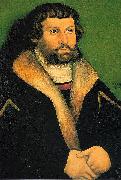 |
Hans Cranach
|
|
(ca. 1513-1537), also known as Johann Lucas Cranach, was a German painter, the oldest son of Lucas Cranach the Elder. German art historian Christian Schuchardt, who discovered his existence, credits him with an altar-piece at Weimar, signed with the monogram "H. C.", and dated 1537. He died at Bologna in 1537. Luther mentions his death in his "Table Talk", and Johann Stigel, a contemporary poet, celebrates him as a painter.
|
|
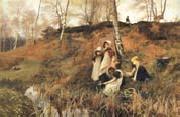 |
Hector Caffieri
|
|
British,the New Water Colour Society which later became the Royal.1847-1832
|
|
 |
HEEM, Cornelis de
|
|
Dutch painter (b. 1631, Leiden, d. 1695, Antwerpen).
Son of Jan Davidsz. de Heem. He spent a great deal of his life in Antwerp, where he was taught by his father. Cornelis also worked in Utrecht in 1667, in nearby IJsselstein in 1676 and in The Hague from 1676 for more than ten years. His best works approach the quality of his father's, particularly in works executed during the decade starting in 1655. Cornelis's still-lifes can be distinguished by daring colour harmonies, sometimes with a strong blue. His compositions are often simpler: fruit-pieces, floral bouquets, festoons and garlands and sumptuous still-lifes, |
|
|
|
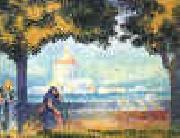 |
Henri Edmond Cross
|
|
1856-1910
French
Henri Edmond Cross Locations
French painter and printmaker. The only surviving child of Alcide Delacroix, a French adventurer and failed businessman, and the British-born Fanny Woollett, he was encouraged as a youth to develop his artistic talent by his father cousin, Dr Auguste Soins. He enrolled in 1878 at the Ecoles Academiques de Dessin et d Architecture in Lille, where he remained for three years under the guidance of Alphonse Colas (1818-87). He then moved to Paris and studied with Emile Dupont-Zipcy (1822-65), also from Douai, whom he listed as his teacher when exhibiting at Salons of the early 1880s. His few extant works from this period are Realist portraits and still-lifes, painted with a heavy touch and sombre palette (example in Douai, Mus. Mun.). |
|
 |
Henri-Edmond Cross
|
|
(May 20, 1856 - May 16, 1910) was a French pointillist painter.
Cross was born in Douai and grew up in Lille. He studied at the École des Beaux-Arts. His early works, portraits and still lifes, were in the dark colors of realism, but after meeting with Claude Monet in 1883, he painted in the brighter colors of Impressionism. In 1884, Cross co-founded the Societe des Artistes Independants with Georges Seurat. He went on to become one of the principal exponents of Neo-Impressionism. He began his Pointillist period after spending time with Paul Signac in 1904. His later works are Fauvist, perhaps influenced by his acquaintance with Henri Matisse.
His final years, plagued by rheumatism, were spent in Saint-Clair[disambiguation needed ], where he died in 1910. His pieces include The Church of Santa Maria degli Angely Near Assisi (1909) and Landscape with Stars.
The Allen Memorial Art Museum (Oberlin College, Ohio), the Block Museum of Art (Northwestern University, Illinois), The Art Institute of Chicago, the Fine Arts Museums of San Francisco, Harvard University Art Museums, the Hermitage Museum, the Honolulu Academy of Arts, Kröller-Meller Museum, the Los Angeles County Museum of Art, the Metropolitan Museum of Art, Museum of Grenoble (Grenoble, France), Musee d'Orsay (Paris), Musee Malraux (Le Havre, France), Musee Richard Anacreon (Granville, France), the Museum of Modern Art (New York City), the National Gallery of Art (Washington D.C.), New Art Gallery (Walsall, England), the Tel Aviv Museum of Art and the Thyssen-Bornemisza Museum (Madrid), are among the public collections holding works by Henri-Edmond Cross.
|
|
 |
Henry Charles Bryant
|
|
(1835 - 1915) was a popular painter of portraits and landscapes specialising in farmyard and market scenes which were noted for their great attention to detail. He worked mainly in London and exhibited frequently between 1860 and 1880 at the Royal Academy, the British Institution and the Royal Society of British Artists. His paintings are highly sought after today.He died at 49, Derby Road, Portsmouth in January, 1915(Obituary:- Hampshire Telegraph & Post, January 8, 1915).
|
|
|
|
|
|
|
|
|
|
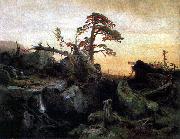 |
Hermann August Cappelen
|
|
(1 May 1827 - 8 March 1852) was a Norwegian painter. Cappelen was best known for his melancholic, dramatic and romantic landscape compositions.
Hermann August Cappelen was born in Skien, Norway. He was the son of Diderik von Cappelen (1795-1866) and Margaret Noble Severine Henriette Løvenskiold (1796-1866). Both the Løvenskiold and Cappelen families were prominent Norwegian family of merchants, land owners, civil servants and politicians. His family were the owners of prominent iron works and various other properties. His grandfather, Diderik von Cappelen (1761-1828), was member of the Norwegian Constituent Assembly at Eidsvoll in 1814.
He grew up at Holden, a manor in Ulefoss in the Grenland district of the county of Telemark. After school graduation in Skien in 1845, he went to Christiania to take another exam at the University of Oslo. He subsequently went to Dusseldorf, where he studied with Hans Gude. Cappelen was a student at Kunstakademie Dusseldorf under Johann Wilhelm Schirmer in landscape painting class (1846-1850). |
|
|
|
|
|
 |
Hieronimo Custodis
|
|
(also spelled Hieronymus, Heironimos) (died c. 1593) was a Flemish portrait painter active in England in the reign of Elizabeth I.
A native of Antwerp, Custodis was one of many Flemish artists of the Tudor court who had fled to England to avoid the persecution of Protestants in the Spanish Netherlands.He is thought to have arrived in England sometime after the fall of Antwerp to the forces of the Duke of Parma in 1585.
Three English portraits by Custodis signed and dated 1589 firmly establish him as resident in London by that year. Sir Roy Strong attributes a portrait of Sir Henry Bromley dated 1587 to Custodis, suggesting an earlier arrival, and has verified the recent attribution of a portrait of the young Edward Talbot dated 1586 to Custodis.In 1591, he was living in the parish of St Bodolph-without-Aldgate where "Jacobus the son of Ieronyme Custodis A Paynter" was baptised on 2 March. He is assumed to have died in 1593, as all of his known works are dated between 1589 and 1593, and his widow remarried that year.
Custodis's unsigned but dated works are idenitified by "palaeographical peculiarities" in the inscriptions which can be closely matched to those in his signed portraits.
|
|
|
|
 |
Hippolyte camille delpy
|
|
French, 1842-1910
was a painter. Delpy came from a moderately wealthy family from Joigny, in the Burgundy region of France. He was a student of Charles Francois Daubigny. |
|
|
|
|
|
 |
Hugh Carroll Frazer
|
|
(February 22, 1891 - July 9, 1975) was born in the Martinsburg, West Virginia. He graduated from the United States Naval Academy in 1912. He received the Medal of Honor for actions at the United States occupation of Veracruz, 1914. Frazer was a World War I veteran. |
|
 |
Ignacio Pinazo Camarlench
|
|
Spanish painter , 1849-1916
was a Spanish painter, and one of the most prominent artists of Valencia from the end of the nineteenth century, working in the Impressionist style. Born into a poor family, Pinazo was forced from a young age to assist in supporting the family by practising various trades. He had only attended eight grades when his mother died of the cholera, and young Ignazio was variously employed as a silversmith, a painter of tiles, and a decorator of fans. After his father's death, he lived with his grandparents, and in 1864 enrolled in the San Carlos Academy of Fine Arts, Valencia, earning his living as a hatter. His artistic career started when he was 21, and he achieved his first success in Barcelona three years later. In 1871, work by him was displayed in the National Exhibition of Fine Arts for the first time. He visited Rome twice, the first time (1873) thanks to the sale of a painting. From 1876 to 1881 he lived in that city on a grant. When he returned to his native city in 1874, he abandoned the conventional historic themes he had so far devoted his efforts to, and instead started painting family subjects, nude figures, and scenes from daily life, thereby anticipating Joaqu'n Sorolla y Bastida and Francisco Domingo both in subject and style. |
|
|
|
|

